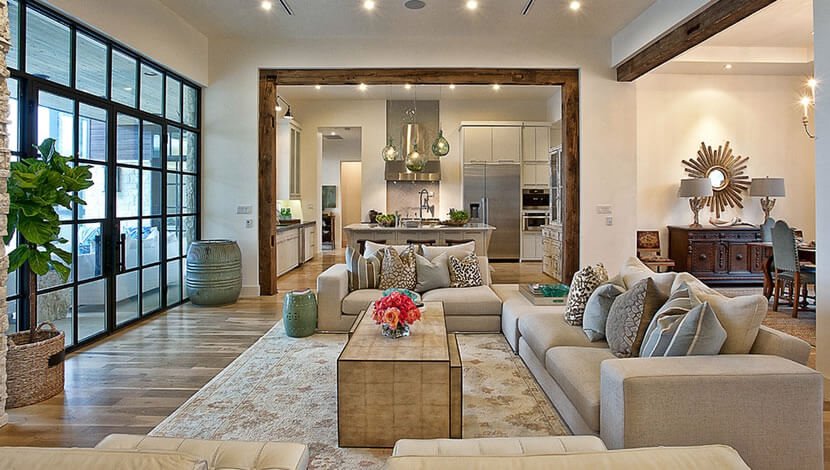A home is more than just a collection of rooms—it’s a living space with personality, rhythm, and flow. But in many houses, especially those built or updated in stages, the interior design can feel disjointed. Different colors, finishes, layouts, or decades of stylistic change can make a home seem visually and functionally fragmented.
That’s where thoughtful interior remodeling comes in. Rather than simply upgrading individual rooms, this approach focuses on creating harmony across the entire home. When each area feels connected, the result is not only more beautiful—it’s more comfortable and intuitive to live in.
Why Cohesion Matters in Home Design
When a home lacks cohesive design, it can feel like something’s always slightly “off,” even if the individual rooms are well-decorated. The transition from one space to another may feel abrupt or jarring. The kitchen might be ultra-modern, while the adjacent living room is still traditional. Or a bathroom remodel might stand out awkwardly in an otherwise outdated floor plan.
Interior remodeling provides the opportunity to tie everything together. Cohesion doesn’t mean every room needs to look identical—it means they complement each other. This visual and functional alignment creates a sense of flow that makes a home feel larger, more open, and more welcoming.
Start by Assessing the Disconnects
Before making any changes, walk through your home and observe how the rooms relate to one another. Take note of:
- Flooring transitions from room to room
- Wall colors and lighting fixtures
- Furniture styles and placement
- Trim, doors, and hardware differences
- Flow and sightlines between connected spaces
Identifying where the inconsistencies lie helps guide your remodeling priorities. If your kitchen remodeling project features sleek, modern lines, consider how the nearby dining or living areas could reflect that same aesthetic—even with small updates.
Establish a Unified Color Palette
Color is one of the most powerful tools in creating visual unity. A consistent palette across rooms gives the entire home a more connected, intentional look. This doesn’t mean painting every wall the same color, but selecting a range of complementary shades and finishes.
For example, soft neutrals might flow from room to room, while accent colors like navy or emerald green appear in furniture, decor, or artwork throughout the home. Even if rooms serve different functions, the shared palette makes them feel part of a whole.
When embarking on a bathroom remodeling or kitchen remodeling project, incorporating this color strategy can ensure the updates blend seamlessly with adjacent areas.
Use Flooring to Connect Spaces
One of the most noticeable differences between rooms is often the flooring. In many older homes, each area may feature a different material—tile in the entry, carpet in the living room, wood in the hallway. This fragmentation can make even large homes feel choppy.
Interior remodeling gives you a chance to rethink flooring transitions. Using the same flooring across shared spaces—such as hardwood, luxury vinyl, or large-format tile—helps unify the design. If a full replacement isn’t in the plan, consider choosing new flooring that echoes the tone or texture of adjacent rooms to maintain visual flow.
Rethink Layout for Better Function
Cohesion isn’t just visual—it’s also about function. Do the spaces in your home work well together, or do they feel isolated and disconnected? Open floor plans are one way to improve flow, but even smaller layout changes can make a big difference.
For example:
- Widening doorways between rooms
- Replacing swinging doors with pocket or barn doors
- Aligning ceiling treatments or trim work
- Creating shared focal points (like a double-sided fireplace)
If you’re considering both kitchen remodeling and interior remodeling at large, this is the time to assess how those spaces interact. Could removing a wall create better sightlines? Would a new island or built-in storage enhance usability across rooms?
Character Interiors recognizes the importance of balancing aesthetic and function. Interior remodeling isn’t just about change—it’s about improvement that respects how a home is actually lived in.
Consistent Fixtures and Finishes
Another way to bring cohesion to your interior is through hardware, fixtures, and finishes. These details—though small—have a big impact on how a space feels. Mixing too many metals or styles can make a home look cluttered or chaotic.
Instead, select a primary finish (like matte black, brushed nickel, or aged brass) and carry it through across lighting, faucets, cabinet handles, and door hardware. This creates a sense of continuity that ties each room together.
If you’re remodeling your bathroom, for instance, choose fixtures that echo those in your kitchen or other living areas. Similarly, coordinate backsplash materials, countertop finishes, or tile choices to reflect a unified vision.
Lighting for Mood and Continuity
Lighting plays a crucial role in setting the tone of a home. A thoughtful lighting plan can enhance architecture, improve function, and build cohesion across rooms.
Use a combination of:
- Ambient lighting for general brightness
- Task lighting for specific activities
- Accent lighting for highlighting design features
Consider using similar fixture styles or finishes in adjacent rooms. Recessed lighting might unify ceilings in open-plan spaces, while pendant lights in both the kitchen and dining area create visual rhythm.
Additionally, pay attention to color temperature. Warm, consistent lighting throughout your home creates a smoother transition between spaces and feels more comfortable overall.
Bring It All Together with Architectural Details
Details like crown molding, baseboards, doors, and trim often go unnoticed—but they have a big influence on how connected a home feels. Varying styles can interrupt flow, even if the rest of the decor is aligned.
Interior remodeling gives you a chance to standardize these architectural features. Matching door styles and trim profiles creates subtle consistency. Updating baseboards or adding wall paneling across multiple rooms builds cohesion and adds charm.
Even if you’re only focusing on one major project—like a bathroom remodeling update—consider how surrounding details contribute to the overall aesthetic.
Avoid Over-Matching
While cohesion is the goal, uniformity isn’t. Homes still benefit from variety and personality. The key is to find balance: enough consistency to guide the eye, with enough contrast to keep it interesting.
Use shared materials, colors, and layouts as a framework, then layer in unique elements—like bold tile in a guest bathroom, or textured wallpaper in a hallway. These individual touches bring life to the space without breaking the visual flow.
Final Thoughts
Interior remodeling is more than just fixing or updating rooms—it’s about creating a space that feels whole. When a home is designed with cohesion in mind, it becomes more than the sum of its parts. Every transition, sightline, and finish plays a role in making your home feel balanced, welcoming, and tailored to your lifestyle.
Whether you’re focused on kitchen remodeling, bathroom remodeling, or whole-home updates, take time to consider how each decision supports a unified vision. Companies like Character Interiors understand that remodeling isn’t just about what you change—but how those changes work together to elevate your entire space.
Read More From Techbullion



































